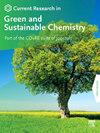利用诺维毕赤酵母和热带假丝酵母回收豆腐废水生产β-葡聚糖
Q2 Materials Science
Current Research in Green and Sustainable Chemistry
Pub Date : 2025-01-01
DOI:10.1016/j.crgsc.2025.100445
引用次数: 0
摘要
本研究旨在确定豆腐废水作为酵母生长培养基的适用性,确定酵母产生β-葡聚糖的最佳生长时间,以及β-葡聚糖提取物的产量和特性。提取诺维毕赤酵母和热带念珠菌细胞壁中β-葡聚糖。利用红外光谱、固体核磁共振和扫描电镜研究其纯度、结构差异和抗氧化活性。热带假丝酵母(BCT)的β-葡聚糖粗收率为3.20%,诺贝吉诺毕赤酵母(BPN)的粗收率为2.10%。FTIR显示甘露糖蛋白-壳聚糖复合物中含有β-葡聚糖杂质。BPN和BCT在1075、1041和894 cm−1处有β-葡聚糖带。结果表明,BPN和BCT在4.803 ~ 4.587 ppm和4.764 ~ 4.541 ppm的化学位移宽信号分别对应于1 β-1,3-葡萄糖苷和β-1,6-葡萄糖苷键,在5.094 ~ 5.024 ppm有异常的端粒共振,BPN和BCT呈多孔片状纤维状。BPN对DPPH自由基的清除能力为20.07%,BCT为36.01%。本文章由计算机程序翻译,如有差异,请以英文原文为准。

Tofu Wastewater Recovery for β-glucan Production by Pichia norvegensis and Candida tropicalis
This study aims to determine the applicability of tofu wastewater as a medium for yeast growth and to determine the optimal growth time of yeast to produce β-glucans, as well as the yield and characteristics of β-glucans extract. Pichia norvegensis and Candida tropicalis cell walls were extracted for β-glucan. FTIR, solid-state NMR, and SEM were utilized to investigate purity, structural differences, and antioxidant activity. Candida tropicalis (BCT) yielded 3.20 % crude β-glucan, while Pichia norvegiensis NYI (BPN) yielded 2.10 %. FTIR showed β-glucan impurities in mannoprotein-chitosan combinations. BPN and BCT have β-glucan bands at 1075, 1041, and 894 cm−1. The impurity of both samples was confirmed by NMR spectra, which showed that the broad signal of BPN and BCT chemical shift at 4.803–4.587 ppm and at 4.764–4.541 ppm, respectively, corresponded to l β-1,3-glucosidic and β-1,6-glucosidic linkage, with some unusual anomeric resonance at 5.094–5.024 ppm by SEM, BPN and BCT were porous, sheet-like, and fibrous. BPN had 20.07 % DPPH radical scavenging activity, while BCT had 36.01 %.
求助全文
通过发布文献求助,成功后即可免费获取论文全文。
去求助
来源期刊

Current Research in Green and Sustainable Chemistry
Materials Science-Materials Chemistry
CiteScore
11.20
自引率
0.00%
发文量
116
审稿时长
78 days
 求助内容:
求助内容: 应助结果提醒方式:
应助结果提醒方式:


